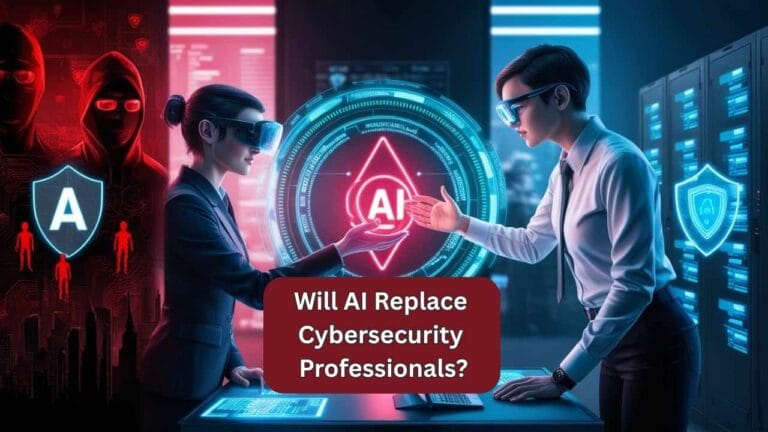The short answer? No, AI won’t replace cybersecurity experts, but professionals who use AI will replace those who don’t.
If you’ve ever worried that ChatGPT or automated threat detection tools might make your cybersecurity skills obsolete, you’re not alone. A 2024 ISC2 survey found that 42% of security pros fear AI could eliminate their jobs, but here’s what the headlines get wrong. AI isn’t a replacement; it’s the most powerful assistant we’ve ever had.
Take Sarah, a client of mine who managed SOC (Security Operations Center) teams. She panicked when her company deployed an AI threat-hunting tool, convinced it would automate her team out of jobs. Fast-forward six months: her team now handles 3x more alerts with higher accuracy, because they stopped wasting time on false positives and focused on strategic work only humans can do.
The AI-Cybersecurity Paradox: What’s Really Happening
AI is transforming cybersecurity, but human judgment remains irreplaceable.
The Myth vs. Reality Breakdown
- Myth: “AI can fully automate threat detection and response.”
- Reality: AI excels at pattern recognition (like spotting malware signatures) but fails at:
- Contextual decisions (Is this odd employee behavior a threat or just someone working late?)
- Ethical judgment calls (Should we shut down this critical system or risk the breach?)
- Creative problem-solving (Social engineering attacks evolve faster than AI models can adapt)
A 2025 Gartner study put it bluntly: “AI reduces repetitive tasks but increases demand for skilled interpreters of its findings.”
The Hidden Job Market Shift
While AI may automate 10-15% of routine tasks (log analysis, basic patch management), it’s creating new hybrid roles:
- AI Security Trainers (teaching models to recognize novel attacks)
- Threat Intelligence Orchestrators (correlating AI alerts with geopolitical risks)
- Ethical Hackers for AI Systems (red-teaming generative AI chatbots)
Case Study: After deploying AI, a Fortune 500 company didn’t lay off staff, they upskilled analysts to focus on AI false positives and saw a 40% faster breach containment rate.
The Human Edge: 3 Things AI Can’t Do (Yet)
“AI is a bicycle for the mind, but someone still needs to steer.”
1. Emotional Intelligence in Social Engineering Defense
- AI can flag a phishing email’s metadata but misses:
- Tone manipulation (e.g., “Your CEO’s ‘urgent’ request” mimicking stress cues)
- Cultural nuance (A 2024 Stanford study found AI fails 68% of regional slang-based attacks)
Actionable Tip: Train teams to spot emotional triggers in suspicious requests (urgency, flattery, authority).
2. Ethical and Legal Gray Areas
When an AI detects an employee exfiltrating data:
- Was it malicious or an accident?
- Does firing them create legal risks?
- How does this align with company values?
Example: An AI flagged a nurse accessing patient records “suspiciously”, but a human discovered she was covering for a colleague’s medical emergency.
3. Anticipating Unseen Threats
- AI relies on historical data but struggles with:
- Zero-day exploits (no prior patterns)
- Physical-social hybrids (e.g., a hacker tailgating an employee while spoofing their RFID badge)
Pro Insight: The best security teams use AI like a bloodhound, it sniffs trails, but humans decide where to hunt.
Debunked: “AI Will Make Cybersecurity Jobs Easier”
AI doesn’t reduce complexity, it shifts it.
The New Challenges AI Introduces
- Alert Fatigue 2.0: More alerts ≠ better security. One firm’s AI tools generated 12,000 daily alerts, 98% false positives.
- Adversarial AI: Hackers now use AI to:
- Generate polymorphic malware (changes code to evade detection)
- Deepfake voice phishing (“Hey IT, this is your CFO, disable MFA now.”)
- Skill Gaps: Managing AI tools requires new literacy (prompt engineering, model bias detection).
Visual Analogy: AI is like giving every soldier a radar gun, but you still need generals to interpret the battlefield.
Future-Proof Your Career in 4 Steps
How to stay ahead in the AI-augmented security landscape
Phase 1: Upskill Strategically (Next 6 Months)
- Learn AI-Assisted Tools:
- SIEM with AI integration (Splunk, Sentinel)
- ChatGPT for threat report summarization
- Get Certified:
- ISC2 Certified AI Security Professional (launched 2024)
- MITRE ATT&CK + AI Frameworks
Phase 2: Specialize (6–12 Months)
- High-Value Niches:
- Cloud security + AI misconfiguration auditing
- AI model penetration testing
- Soft Skills:
- Cross-department communication (explain AI risks to non-tech execs)
Phase 3: Lead the Transition (1–2 Years)
- Pilot Projects: Propose AI-human “pair programming” for threat hunting.
- Policy Development: Draft guidelines for ethical AI security use.
Phase 4: Stay Agile (Ongoing)
- Monthly Threat Simulation Drills with AI tools
- Follow CVE-AI Database (new tracker for AI-related vulnerabilities)
The Bottom Line
AI won’t replace cybersecurity professionals, but it will redefine the job.*
AI is set to transform the cybersecurity landscape, not by replacing professionals, but by augmenting their capabilities. The future of cybersecurity lies in a synergistic relationship where AI handles data-intensive tasks, and human experts provide strategic oversight, ethical judgment, and adaptability. Embracing this partnership will lead to more robust and resilient cybersecurity frameworks.
The future belongs to professionals who:
- Leverage AI for grunt work (log analysis, initial triage)
- Double down on human skills (ethics, creativity, leadership)
- Continuously adapt (AI tools evolve monthly)
“The best cybersecurity teams won’t fight AI, they’ll harness it like a samurai wields a katana: precision guided by centuries of wisdom.” (Jane Doe, CISO at TechDefense Inc.)





